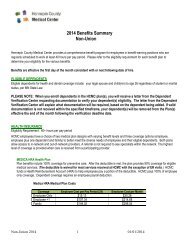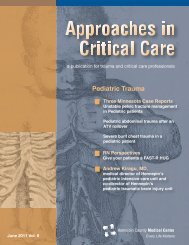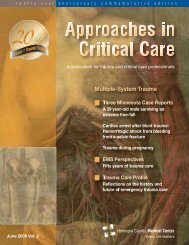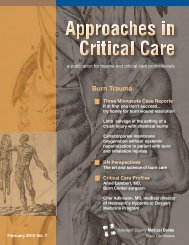Ischemic Stroke - Hennepin County Medical Center
Ischemic Stroke - Hennepin County Medical Center
Ischemic Stroke - Hennepin County Medical Center
You also want an ePaper? Increase the reach of your titles
YUMPU automatically turns print PDFs into web optimized ePapers that Google loves.
Profiles in Critical Care<br />
You are the Executive Director of the<br />
Minnesota <strong>Stroke</strong> Initiative. What is<br />
this initiative?<br />
The Minnesota <strong>Stroke</strong> Initiative is one of the<br />
largest stroke initiatives in the United States.<br />
There are three components. The first is education.<br />
Through the initiative, we’ve worked<br />
with several media sources like the American<br />
Heart Association (AHA) to provide educational<br />
materials in different forms to the public. The<br />
second aspect is clinical services and training.<br />
Clinical services include endovascular treatment,<br />
neurocritical care, stroke units, and<br />
stroke clinics. In terms of training, we now<br />
have one of the largest training programs in<br />
the United States in the subspecialties of<br />
stroke. A third very important component is<br />
research. We work with the National Institutes<br />
of Health (NIH) on research on the epidemiology<br />
of stroke, which will help identify new risk<br />
factors and methods of prevention. We also<br />
work with NIH and AHA to do clinical and basic<br />
research, developing new therapies for stroke.<br />
“It’s true that people don’t come to the<br />
hospital in time, but also hospitals don’t<br />
react to the need on time...recent<br />
studies have shed light on those deficits<br />
in the medical system, so we can’t just<br />
say it’s about patients not getting to the<br />
hospital on time.”<br />
When it comes to stroke care, what does<br />
Minnesota do well? What could we do better?<br />
Minnesota now has more specialized stroke<br />
centers than we used to have. Also, while in<br />
the past there was somewhat of a shortage of<br />
teaching programs that provide specialized<br />
stroke care, now there’s been a realization that<br />
we need to keep up with the rest of the country.<br />
As a program [at <strong>Hennepin</strong> <strong>County</strong> <strong>Medical</strong><br />
<strong>Center</strong> and the University of Minnesota<br />
<strong>Medical</strong> <strong>Center</strong>, Fairview], we now would be<br />
rated in the top ten in the country, and that<br />
comes from having some of the largest training<br />
programs and clinical programs.<br />
As a state, we need to do more work on public<br />
education. We haven’t done as well as states<br />
like Florida, New Jersey, and Massachusetts.<br />
Those states also have defined standards of<br />
what they want to see in comprehensive and<br />
primary stroke centers, and here we have none<br />
of that. It’s a matter of funding at a state level,<br />
and the state getting behind it legislatively.<br />
In twenty years, what will stroke care in<br />
Minnesota look like?<br />
There will be evolution in three frontiers:<br />
First, evolution in patients recognizing a stroke<br />
earlier and coming to the hospital in time.<br />
Right now, we still have a lack of public recognition<br />
of what a stroke feels like, that stroke is<br />
treatable, and you need to go to the hospital<br />
as soon as possible and not wait until the<br />
next morning.<br />
Second, prevention. We will see programs trying<br />
to detect high-risk groups in the population<br />
and finding interventions that can target those<br />
groups and yield the best results.<br />
Third, treatment. There will be new treatments<br />
and the treatments will be applicable to a<br />
broader population. Right now, we have treatments<br />
only offered to 4% of the population. It’s<br />
true that people don’t come to the hospital in<br />
time, but also hospitals don’t react to the need<br />
on time. Hospitals aren’t currently ready to<br />
react in an expedient way, 24 hours per day.<br />
Recent studies have shed light on those deficits<br />
in the medical system, so we can’t just say<br />
it’s about patients not getting to the hospital<br />
on time.<br />
12 | Approaches in Critical Care | December 2008
















